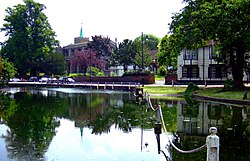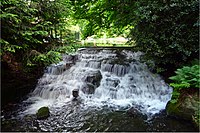Carshalton
| Carshalton | |
| Surrey | |
|---|---|
 Carshalton, by upper pond | |
| Location | |
| Grid reference: | TQ275645 |
| Location: | 51°21’55"N, 0°10’3"W |
| Data | |
| Post town: | Carshalton |
| Postcode: | SM5 |
| Dialling code: | 020 |
| Local Government | |
| Council: | Sutton |
| Parliamentary constituency: |
Carshalton and Wallington |
Carshalton is a suburban area of Surrey within the metropolitan conurbation. It is found in the valley of the River Wandle, one of the sources of which is Carshalton Ponds in the centre of the village.[1]
Carshalton lies within Wallington hundred.
In and around the town
Central Carshalton, around the ponds and High Street, retains a village character, although the busy A232 runs through the area. There are a number of attractive buildings and open spaces protected by the Carshalton Village Conservation Area.[2]
Carshalton-on-the-Hill is the residential area on the high ground to the south of Carshalton Park around Boundary Road, Stanley Road and Stanley Park Road and stretching out towards the smallholdings of Little Woodcote.
Carshalton Beeches is the area to the west of Carshalton-on-the-Hill, around Beeches Avenue, Banstead Road and Woodmansterne Road. It grew up around the railway station which was named after Beeches Avenue, the street in which it is located; which, in turn, is named after the beech trees which line it.
The Wrythe, or Wrythe Green, lies between Carshalton village to the south and St Helier to the north-west. Its name is thought to derive from the rye that was once grown in this area, or from the Old English word rithe which means a small stream.[3] During the time of the Roman occupation of the British Isles, a small spring was situated near the green, now shadowed by a BP garage. Roman activity in the area is confirmed by the fact that there was once a Roman Villa built in Beddington, just a couple of miles away, and a number of roads in the vicinity of Roman origin. The spring has since disappeared under ground and the culvert it feeds flows into the Wandle near Hackbridge.
Churches
- Church of England:
- All Saints: the parish church, parts dating from the 12th century
- Baptist:Carshalton Baptist Church
History

To the south of the area now known as Carshalton, remains of artefacts dating from the Neolithic to the Iron Age have been found, suggesting that this was an early place of habitation.[4] Before the Norman Conquest it is recorded that there were five manors in this location owned by five freemen.[5]
Carshalton appears in Domesday Book as Aultone. It was held by Goisfrid (Geoffrey) de Mandeville. Its Domesday assets were: 3½ hide (unit)|hides; 1 church, 10 ploughs, 1 Mill (grinding)|mill worth £1 15s 0d, 22 acres of meadow, woodland worth 2 hogs. It rendered £15 10s 0d.[6]
Carshalton was known for its springs; these may have given the place its name, with "Aulton" meaning "well town". The Cars- element is later and uncertain but early spellings (Kersaulton and Cresaulton) may indicate connection with watercress grown locally (Old English cærs).
In his book History of the Worthies of England, the 17th century historian Thomas Fuller refers to Carshalton for its walnuts and trout.
Land was primarily put to arable use and the river Wandle gave rise to manufacturing using water power. A water mill to grind corn was mentioned in the Domesday Book. By the end of the 18th century it was recorded that there were several mills for the production of paper and parchment, leather, snuff, log-wood and seed oil. There were also bleaching grounds for calico.[5][3] During the Victorian Age and into the early 20th century, Carshalton was known for its lavender fields,[7] but the increasing land demand for residential building put an end to commercial growing.
The Commonwealth War Graves Commission lists 78 civilian casualties in Carshalton during Second World War.
Landmarks
All Saints Church
The parish church of All Saints overlooks Carshalton Ponds. A church has stood on this site since at least Norman times and probably much longer. The current church contains 12th century work but has been much extended over the centuries; most dramatically in 1891 when a new nave and north aisle were added.[8]

Just outside the churchyard wall is a spring locally known as "Anne Boleyn's Well". It is popularly said to have received this name because it appeared when Anne Boleyn's horse kicked a stone and a spring of water appeared. Anne was probably riding to or from an assignation with her future husband, King Henry VIII at the nearby home of Sir Nicholas Carew.
Another possible explanation is that the name is a corruption of "Boulogne", since the Counts of Boulogne owned land here in the 12th century and there may have been a chapel dedicated to Our Lady of Boulogne near the well.
Carshalton House Water Tower
The water tower was built in the early 18th century primarily to house a water driven pump supplying water to Carshalton House and its gardens. It was planned as a multi-purpose building, however, and also contains an orangery, a saloon and a bathroom which retains original Delft tiles.
Little Holland House
Little Holland House in Carshalton Beeches was the home of the artist Frank Dickinson (1874–1961). Dickinson's Arts and Crafts style interior was influenced by John Ruskin and William Morris. The house contains many of his art works. It is now occasionally open to members of the public.[9]
Honeywood

Honeywood is a large and attractive house at the western end of Carshalton Ponds. At its earliest it dates from the 17th century but has been much extended and restored, particularly in the period 1896 to 1903. It now houses the London Borough of Sutton's Museum and has a local history collection, including objects that date back to the Bronze Age.
The Oaks bakehouse
The late 19th century bakehouse in Oaks Park is all that remains of "The Oaks" mansion which burned down and was demolished in the 1950s. The original bread oven remains in situ. Blocks of burnt bricks from the ruins of the great house were used by local builders to construct garden walls for houses all along Woodmansterne Road, and may still be seen today.
The Orangery
The Orangery in The Square was built in the second half of the 18th century in Carshalton Park (the section of which between here and Ruskin Road has since been built over). It is now used for commercial office space.
Strawberry Lodge
Constructed in 1685, Strawberry Lodge is one of Carshalton's oldest buildings. It was built by Josias Dewye[10] who was described in records at the time as a 'clothworker and citizen of London'. In the late 17th century Josias moved from Chilworth to Carshalton to run a Gunpowder Mill on the River Wandle and decided to make his home nearby at the lodge.
On the corner of Strawberry Lane and Mill Lane is Strawberry Lodge, owned by Carshalton Baptist Church.[11] Besides being a place of worship it is also used during the week as a conference and training centre. During the 1990s the site was renovated by the Baptist Church.
Parks

Carshalton has many green spaces with three main public parks of note. The present day Carshalton Park was once much larger, but encroachment has stopped and it provides for local recreation. Grove Park, closest to the village, is the best example of a Victorian park in the area. Oaks Park is a large park landscaped in a naturalistic style, providing downland walks.
Events

Annual events include:
- fireworks display at Carshalton Park supporting charities, held on the Saturday nearest to Bonfire Night,[12]
- summer carnival on the second Saturday of June
- beer festival over the first Bank Holiday weekend in May
- Environmental Fair also held in Carshalton Park on the August Bank Holiday Monday.
- Carshalton Charter fair held in September.
There are frequent theatrical and musical productions at The Charles Cryer Studio Theatre, which is situated on the High Street.
The Ecology Centre and Honeywood Heritage Centre also hold regular events and meetings.
The Methodist hall in Ruskin Road is home to the Ruskin Players and the Carshalton Choral Society, both of which perform at regular intervals throughout the year.
The annual Carshalton Lavender harvest weekend is held in July, at Stanley Park Allotments, Carshalton-on-the-Hill.[13]
Notes
- ↑ "London Biodiversity Partnership - audit of rivers document." (PDF). http://www.lbp.org.uk/02audit_pdfs/22_rivers.pdf.
- ↑ "London Borough of Sutton Conservation Areas." (PDF). http://www.sutton.gov.uk/NR/rdonlyres/C6C0DFCB-818F-406C-B16F-5B88D6A4E80E/0/003ConservationAreasinSutton241105.pdf.
- ↑ 3.0 3.1 The Book of Carshalton: At the Source of the Wandle, based on talks by Michael Wilks, published 2002.
- ↑ The Victoria History of the County of Surrey: Vol 4, edited by H.E.Malden, published 1912.
- ↑ 5.0 5.1 "The Environs of London: Vol 1 - County of Surrey" by Daniel Lysons, published 1792.
- ↑ Surrey Domesday Book
- ↑ Volume 16, Page 293 of the 1911 Encyclopaedia Britannica.
- ↑ "Carshalton All Saints - History of Church.". http://www.carshaltonallsaints.org.uk/section/29.
- ↑ "London Borough of Sutton Heritage, Little Holland House.". http://www.sutton.gov.uk/leisure/heritage/Carshalton/lhhintro.htm.
- ↑ "See section entitled 'Chilworth gunpowder mills in the period of the Dutch Wars'.". http://www.surreyarchaeology.org.uk/abstracts.htm.
- ↑ "Carshalton Baptist Church.". http://www.carshaltonbaptist.org/.
- ↑ Carshalton Fireworks.
- ↑ "Carshalton Lavender". http://www.carshaltonlavender.org/.
Outside links
| ("Wikimedia Commons" has material about Carshalton) |
